A to Z of the Amalfi Coast: a guide to the Amalfi Coast
Amalfi Coast, Amalfi Coast, Bookings For You, Inspiration, Italy
A complete guide to the Amalfi Coast – discover magical towns, villages and islands in this majestic corner of Italy.
The Amalfi Coast is one of Italy’s most stunning stretches of coastline. Given UNESCO world heritage status due to it being an outstanding example of a Mediterranean landscape, it covers an area of over 11,000 hectares between the Gulf of Naples and the Gulf of Salerno. Located in the Italian region of Campania, the rugged cliffs of the Amalfi Coast overlook the Tyrrhenian Sea and the Gulf of Salento below. Arguably, it offers visitors some of the most magical vistas anywhere in Italy. Technically speaking, the Amalfi Coast is 34 miles long, however, we have added a couple of towns which strictly do not fall within these parameters. However, since they are also well worth a visit we have added them to this guide to the Amalfi Coast.
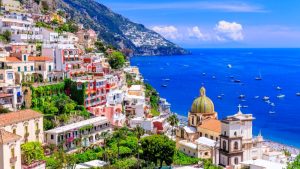
Albori
Albori, a small hamlet of Vietri sul Mare, is a village very typical of those along this stretch of Italian coastline. Sitting 300 metres above sea level, its brightly painted buildings cling to the eastern side of a valley, overlooked by Mount Falerzio. It has deep roots in both agriculture and fishing and these days is home to less than 300 residents. One of Italy’s ‘borghi piu belli‘, its narrow alleyways are enchanting to discover. Of particular note is the Church of Santa Margherita di Antochia in the main square, reached by a staircase inlaid with majolica. Inside, there are some fabulous frescoes painted by the late 17th and early 18th century Baroque artist Francesco Solimena, as well as paintings by Belisario Corenzio. Why not enjoy a guided trek taking you through the region’s iconic lemon groves from Vietri to Raito, passing through this charming village. Book here with our trusted partner Get Your Guide.
Agerola
Sat on the hillside above Furore and Amalfi, Agerola is often affectionately referred to as ‘Little Switzerland.’ It was once famous for both its silk manufacturing (which came to an end in the early 19th century) and for the cultivation of the white ‘rosaria‘ rose which was used in perfumes. However, this industry also died out, this time in the 17th century.
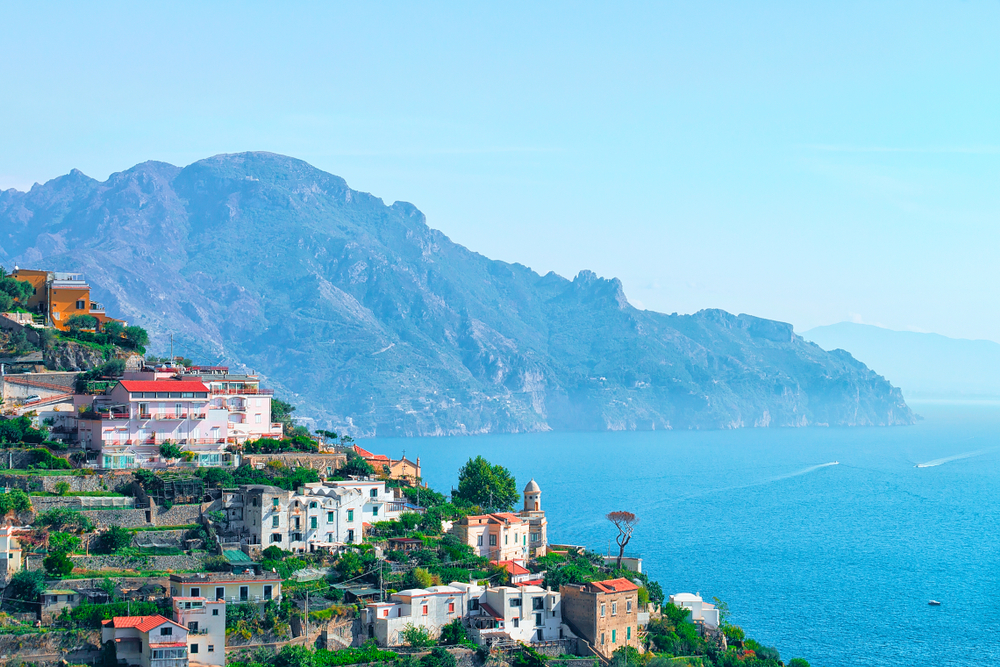
These days, its position between the sea and the Parco Regionale dei Monti Lattari means its a particularly popular destination for hikers, attracted by the beautiful scenery of the mountain landscape. Visit just before Easter each year to participate in the Processione dei Battenti which takes place on Holy Friday. The Battenti were friars who used to beat their own backs with a double hemp rope, dressed in a white hood to cover their faces. These days, the locals re-enact this ancient tradition.
Amalfi
Amalfi is the main town on the Costiera Amalfitana (Amalfi Coast). As early as the 1920s, it was a popular tourist destination amongst the British aristocracy and upper classes.
Make sure to visit Amalfi’s Duomo complex where you can visit not just the cathedral but also the Cloister of Paradise, the crypt and museum. The patron saint of Amalfi is Saint Andrew and his relics are kept at the heavily decorated Cattedrale di Sant’ Andrea (Duomo) here. Entrance costs just a few euros. Stand outside at the top of the steps leading to the cathedral and you will also be rewarded with a stunning view.
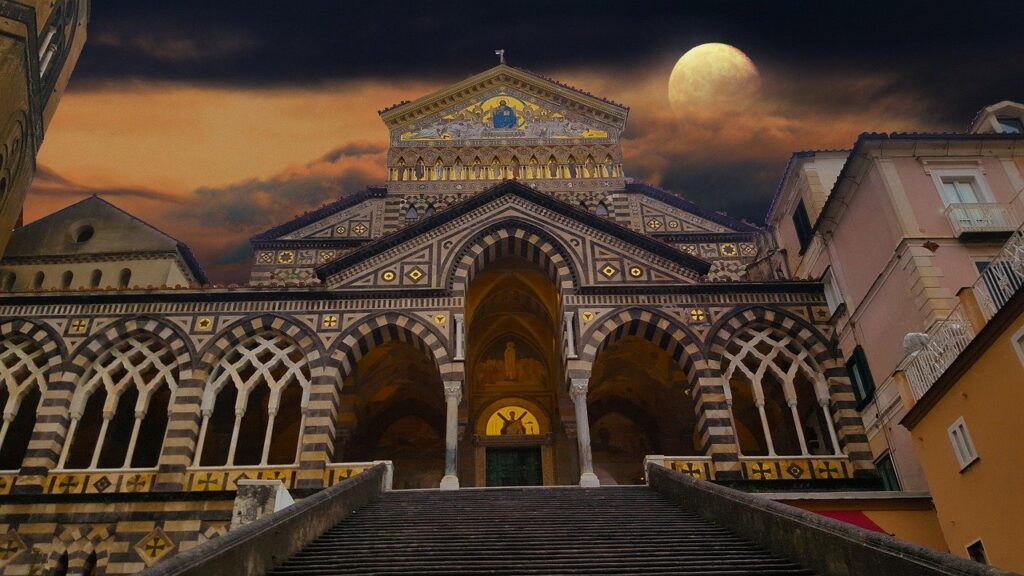
Also in Amalfi is the Museo della Carta (Paper Mill Museum). This is an absolutely charming museum which explores the history of the paper-making industry in this area. It’s also extremely hands on and visitors are given the opportunity to try and make paper for themselves. If you have time, take a walk up through the back of the town of Amalfi, through lemon groves and ruined historic water mills (which would have powered the paper making industry centuries ago) to the Valle delle Ferriere nature reserve, filled with waterfalls, pools and nature.
Finally, it is claimed that Amalfi is the birthplace of limoncelli so it’s also the ideal place to sample this refreshing alcoholic drink or to sample some of the other produce made from the lemons grown in this area. You’ll also find shops selling everything from handmade leather goods to coral jewellery, beautifully painted ceramics and hand-made stationery.
Atrani
A small coastal town, Atrani is arguably one of the prettiest villages anywhere in Italy. Atrani is most famous for its stunning beach, behind which sits the Amalfi Drive and Collegiate Santa Maria Maddalena church. It’s a view that is instantly recognisable these days. And it’s also where you will find a vibrant community of artists. Take a walk to the Church of San Salvatore where you will find a simple stone fountain.
Bomerano
Bomerano is a small village situated above Conca dei Marini. It is most famous for being the starting point of the 9 km Path of the Gods (Sentiero degli Dei) which makes its way from here to Arienzo di Positano, 1 km from Positano itself.
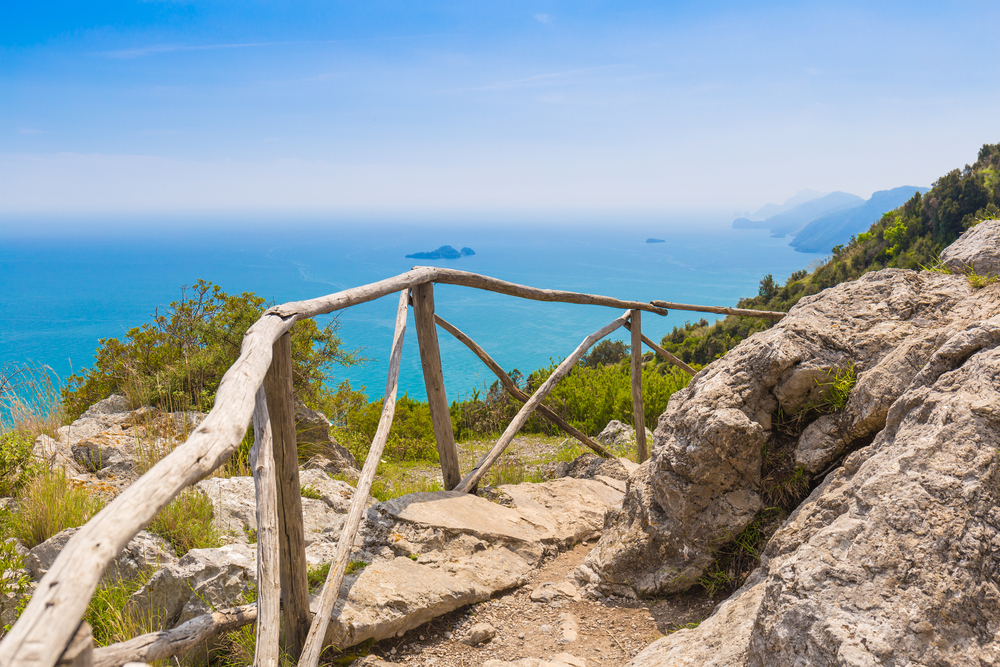
Bomerano’s elevated position also means it tends to be a little cooler than some of the other towns and villages along the Amalfi Coast.
Capri
Capri deserves its reputation as one of the chicest destinations anywhere in Italy. Head over to meader through its narrow streets, lined with designer shops and perfume stores or to laze around in one of its exclusive beach clubs. Capri’s main square is the Piazza Umberto I (the Piazzetta) and the people watching here is highly entertaining.
The other main attraction in Capri is the Blue Grotto. This is an incredible natural cave filled with water that takes on an ethereal blue colour thanks to the sunlight that shines into it. Other famous sites in Capri include the Faraglioni, three dramatic rock formations that rise out of the sea, and the 2000 feet high Monte Solaro. Visitors can either opt for the energetic option of hiking up its slopes or choose instead the more relaxing ride on the funicular to make the most of the stunning views from the summit. Also try and make the time to enjoy a stroll through the picturesque Gardens of Augustus.
The island of Capri is an easy 20 minute boat ride from Sorrento. But, please note that the last boat leaves Capri at 7 pm so make sure you’re at the boat stop on time!
Cava dei Tirreni
Cava dei Tirreni is actually separated from the Amalfi Coast by the Lattari Mountains but we wanted to at least mention it in our A to Z of the Amalfi Coast since it is a popular city and tourist resort. It has a rich and illustrious history that goes back to Roman times (many remains of Roman villas have been discovered here). Head to the city on the first Sunday of July to participate in the Disfidi Dei Trombonieri (Challenge of the Trombonists), a festival and celebration steeped in history.
Cetara
A visit to Cetara is like stepping back in time. A traditional fishing village, it boasts a great beach overlooked by an equally stunning tower. Whilst Italians may know about Cetara, you’ll find it’s off the main tourist trail and so, whilst the beach may still be packed with locals, you won’t tend to find other holidaymakers here.
Watch the local fishermen bring in their catch at sunrise. Cetara is famous for the production of colatura di alici’, the drippings of salted anchovies. When the fish is caught, the anchovies are thrown into wooden barrels, alternated with layers of generous handfuls of salt. The contents are then pressed down by a wooden lift weighted with rocks. In the Winter, the contents are ready when the anchovies have produced their fragrant amber juice.

Cetara is also a good spot if you’re a keen diver. There is an abundance of marine life to explore from here including soft corals across in Capri’s Blue Grotto.
Conca dei Marini
Conca dei Marini is a small town, best viewed from the sea, from where you can marvel at the Borgo Santandrea. Once a fortress, this is now a luxury hotel behind which sits a massive limestone cave. A traditional fishing village, Conca dei Marini doesn’t attract the same number of visitors as its more famous neighbours such as Positano or Ravello, but the whitewashed houses that perch on its rocks, its lemon groves and bountiful flowers that adorn its balconies and streets, make it well worth a visit. It’s also where you will find the Grotta dello Smeraldo, one of the most famous caves in the world. The village stretches along a small bay which is overlooked by the Torre Saracena – a watch tower built in 1563 to prevent probable Saracen pirates.
Dragonea
Dragonea sits 270 metres above sea level, above the town of Vietri Sul Mare. It is possible to walk from one to the other along a 2.5 km path. It’s a quiet village but a very pretty spot, popular with hikers. It is also the site of one of Salerno’s oldest churches – the Church of San Pietro e Paolo.
Erchie
Slightly off the beaten path and away from the main tourist hotspots, Erchie is still very much worthy of a visit. Its name comes from the fact that it was supposedly once home to an ancient temple dedicated to Hercules. In the 10th century, the Benedictine Monastery of Santa Maria de Erchi was founded here. Sadly, it was damaged by both attacks and storms before it was finally abandoned at the end of the 15th century.
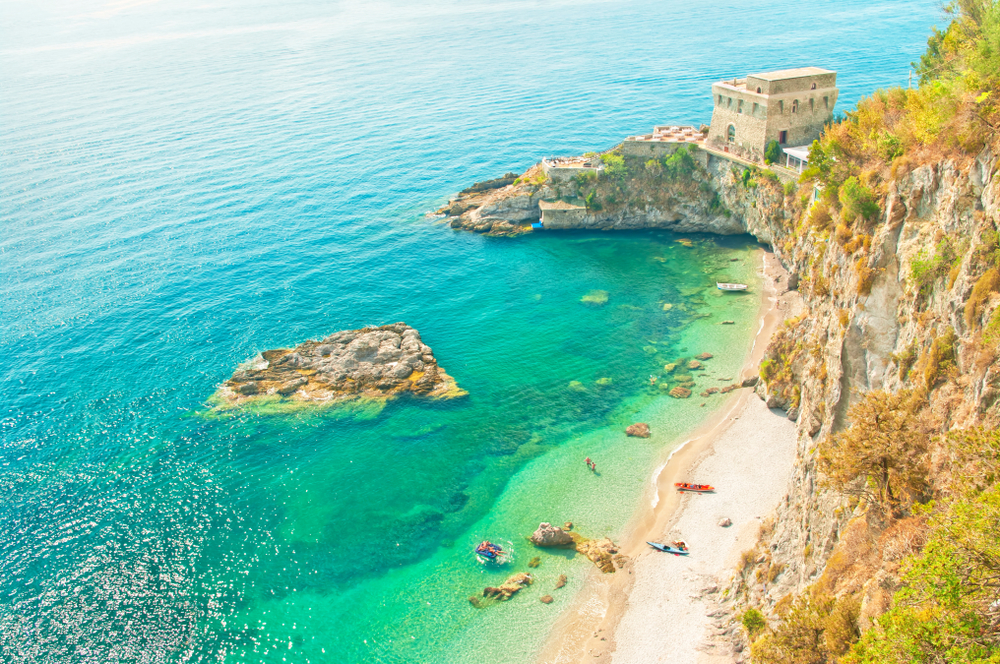
Erchie boasts a small sandy beach area, at the eastern end of which sits the Medieval Torre la Cerniola (dating back to 1278) and is characterised by pretty pastel coloured houses. One of the smallest villages on the Amalfi Coast, it is home to less than 100 permanent residents, most of which are fishermen.
Furore
Furore is a charming residential town, home to the Fiordo di Furore. It can boast neither a central square nor any town centre. In fact, it is nothing more than a narrow cove with a small beach (accessed from the main road via a series of 200 steps) and a sprinkling of small houses that cling to the rocks. But it’s incredibly picturesque and it’s a popular place to swim in the Summer months. Beyond the beach is a small fishing village and a number of paper mills. Keep an eye out for the restored monazzeni, old sheds where fishermen would once have kept their tools. Head to one of the old paper factories to visit Furore’s Eco Museum and botanical garden.
Ischia
Ischia is less famous than its neighbour Capri but it’s actually the largest island in the Bay of Naples. An hour away from Sorrento by boat, it’s arguably most famous for its Aragonese castle.
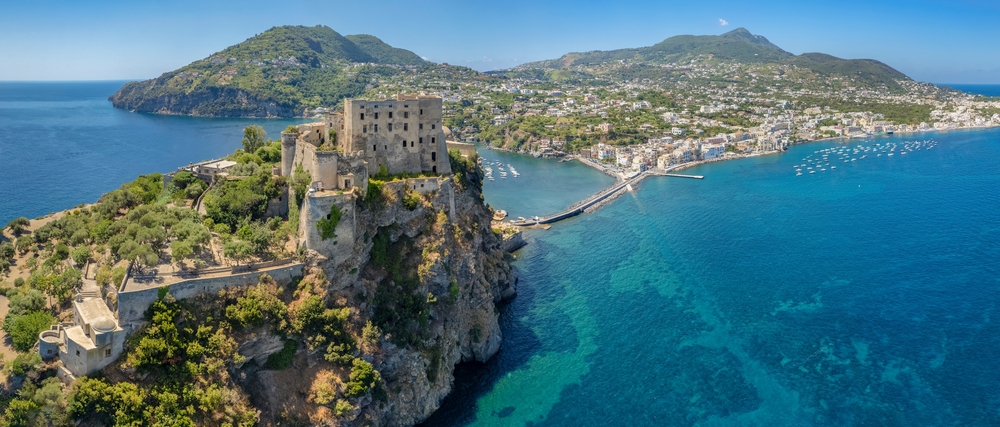
This Medieval castle sits on a rocky islet and is connected to the island by a causeway. However there is much more to Ischia than its castle. The island is home to a number of thermal spas, some beautiful beaches (our favourites are the Maronti beach and the harbour of Sant’ Angelo) and offers some good shopping opportunities along the main shopping street – the Corso Vittoria Colonna.
You’ll find the northern coast of the island busiest. This is home to towns such as Ischia Porto, Forio, Lacco Ameno and Ischia Ponte. The southern coast is much quieter and more laid back. Sant’ Angelo is one of our favourite places. In between the two coastlines you will find vineyards, forests and volcanic rocks towered over by Ischia’s highest peak – Monte Epomeo – which sits 789 metres above sea level.
Maiori
Mairori doesn’t boast much for tourists to see and do, with the exception perhaps of its 11th century Castello Aragonese. This would originally have been built as a watchtower but these days it’s used more as a concert venue every Summer. It does also boast some stunning views though of both the Tyrrhenian Sea and Mount Vesuvius. Maiori also has a pebbled beach and a long promenade that runs alongside it. This is much more a town where you will find the locals shopping. Its main shopping street is the Corso Reginna. If you do visit, we recommend doing so in June when its streets are filled with red poppies that grow wild and in abundance here. It’s extremely pretty. Also grown in this area are olives, oranges and almonds.
Minori
Maiori’s neighbour, Minori, is a charming place to visit. Take a walk along the Via Dante which leads from the town to La Foce Gardens which sit on a clifftop that hangs over the sea below. Also in Minori is the Villa Romana e Antiquarium, home to some beautiful Roman ruins, along with the Basilica of Santa Trofimena. Minori’s beaches are also worth spending time on, if only to enjoy the wonderful views of the azure seas that sit behind Medieval towers.

If you do head here, make sure to also pop in to Sal de Riso, an award-winning pastry shop, to sample the Delizie ai Limone. These are small, cream-filled cakes topped with a thick layer of icing.
Visit in November to also enjoy the annual Film Festival which awards the Premio Internazionale Roberto Rossellini.
Molina
Molina is a hamlet under the municipality of Vietri sul Mare. Its name comes from the Medieval mills that would once have existed along the River Bonea.
Nerano
Nerano is one of the Amalfi Coast’s hidden gems, situated between Positano and Sorrento. It supposedly got its name from the Emperor Nerone who once had a Summer residence here. It also boasts some charming hidden coves and some beautiful beaches which face the bay of the Marina del Cantone. The sea here is ideal for scuba divers thanks to its rocky seabed. Head to the right of the Cantone beach where you will find a picturesque footpath that leads to the white pebbled Recommone beach. This is home to the Concan del Sogno private beach club and restaurant which is popular with the rich and famous.
Whilst you may not be able to enjoy time at the private beach club, stop for a spot of lunch in one of the restaurants that line the shore and sample the town’s speciality – Spaghetti Nerano – a dish of spaghetti tossed with fried courgettes and served in a light, creamy sauce.
Nocelle
Nocelle is a tiny village near Positano. Situated 400 metres above sea level, it can boast some incredible views along the Amalfi Coast. If you are feeling energetic, climb the 1700 steps that leads from here to Positano. It may be tiring but the views are simply breathtaking and well worth the effort! There are numerous other hiking paths that leads through the Lattari mountains that start here too.
Pogerola
Pogerola is a tiny Medieval village that sits 6 km above Amalfi. Built over a series of terraces that cling to the mountainside, as you would expect given its elevated position, it’s another of the Amalfi Coast villages that boasts incredible views.
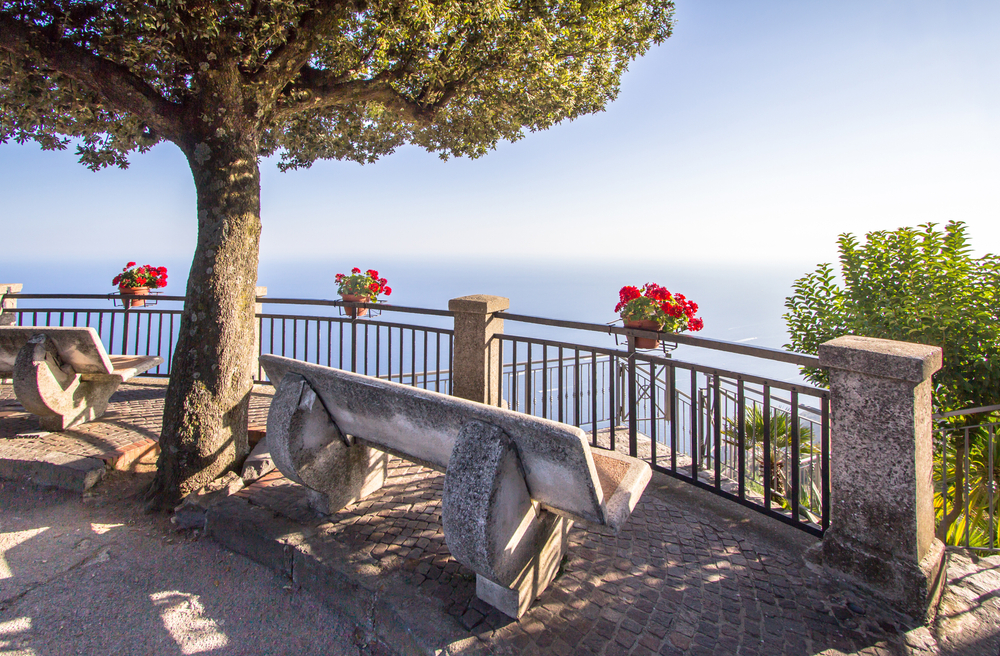
Centuries ago, when it was known as Castrum Pigellula, it would have served as a key defensive position. After all, it was the ideal place to spot any advancing invaders and to quickly warn the Republic of Amalfi. These days its elevated position means its simply a great place from which to admire the view! From the village you can admire sweeping views along the Amalfi coast, across the Bay of Naples to the Li Galli islands and over lemon groves down to the surrounding towns and villages such as Lone and Pastena. In Pogerola itself you’ll find a small collection of shops and restaurants. The main piazza is also home to the 16th century Church of Santa Maria delle Grazie. Also take the time to admire the 12th century Chapel of Santa Maria Vergine and its beautiful portico as well as the similarly aged Church of San Michele.
Pompeii
Whilst Pompeii may no longer be inhabited, it’s a must see on any visit to the Amalfi Coast. Completely covered in ash from the eruption of nearby Mount Vesuvius in AD79, before that it was once a thriving Roman city home to 20,000 residents. These days, the incredibly well preserved site is fascinating to explore. Visitors can wander along its excavated streets, discover its ruined houses, admire its amphitheatre and gymnasium and visit its forum and temples.

Pontone
The hamlet of Pontone is actually officially part of Scala, sitting in the hills above Amalfi and close to Ravello. Its charming village centre is one of the prettiest of any of the hilltop towns along the Amalfi Coast, with a picturesque piazzetta, home to a cafe and church. You can actually walk from Amalfi to Pontone, climbing up the 750 steps to get there. Once there, the ruins of the Basilica of Sant’ Eustachio are well worth seeing. Also head inside the 12th century Church of St John the Baptist, home to a number of 16th century and Baroque paintings. Another church here is the Romanesque Church of Santa Maria del Carmine.
Positano
Positano is one of the Amalfi Coast’s most beautiful towns but this, sadly, does mean that it can get extremely busy. It’s common for cruise ships to bring visitors in each day and so do expect its streets to be crowded but don’t let this put you off.
Pastel coloured houses and domed cathedrals cling to the rocky slopes that lead down to the wide, black sandy beach of Positano. Enjoy some shopping in the many boutiques and independent stores that line these slopes, spend time relaxing on the beach, or take to the water and enjoy some water sports. On your way down, be sure to look out for Pinauro, a bakery famous for introducing Sfogliatella to the town over two centuries ago.
Make sure you head to the top of the town too and climb up Montepertuso to enjoy terrific views not just down over Positano but also nearby Praiano.
Praiano
Praiano is a popular spot with the wealthy and famous, no doubt attracted by the number of exclusive hotels that Praiano is home to along with its plethora of beaches. Of particular note is the Lungomare di Levante, the Marina du Praia and the Cala della Gavitella. However, compared to Positano just 15 minutes away, this fishing village is still relatively quiet and sleepy.
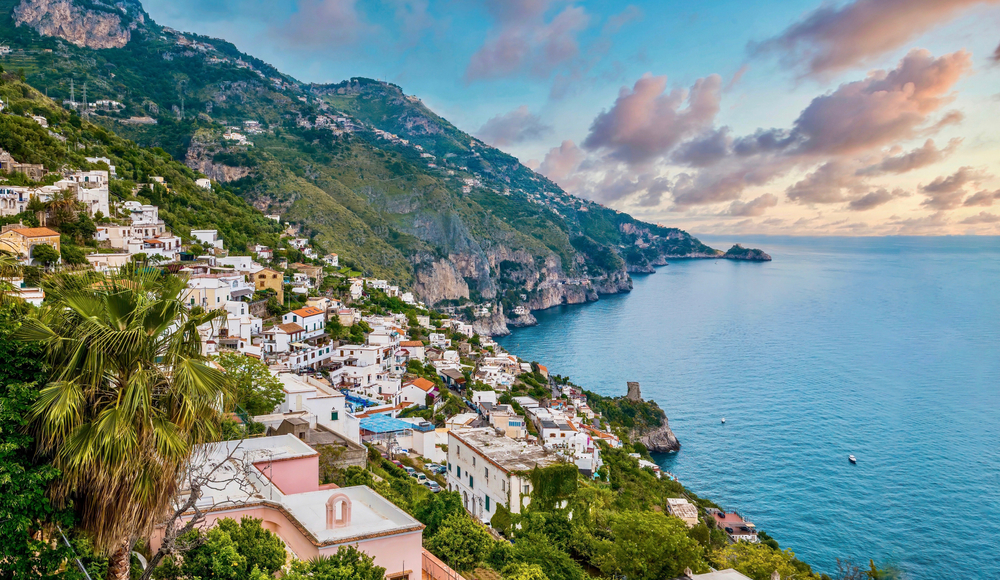
Take a stroll through Praiano’s pretty streets and pathways, lined with charming whitewashed buildings. Keep an eye out for the Church dedicated to San Gennaro, patron saint of Naples and for the Church dedicated to San Domenico. This is the setting for the annual festival of light – Luminaria di San Domenico – which takes place at the end of July or beginning of August each year.
Praiano is also ideally placed for those interested in walking along the Path of the Gods.
Raito
Close to Albori, Raito overlooks the more famous town of Vietri sul Mare, famous for its ceramics industry. To learn more about its history, head to the Museum of Ceramics which is situated in the tower of Villa Guariglia on Monte Falerio in Raito. The museum is also home to works by artists such as Vincenzo Pinto, Giosuè Procida, Giovannino Carraro, Salvatore Procida, Irene Kowalska and Richard Dolken.
Ravello
Ravello is absolutely stunning. Sat in a more elevated spot than many of the other towns and villages on the Amalfi Coast, it enjoys both inland and coastal views. There are a couple of beautiful homes and gardens to explore here – Villa Cimbrone and Villa Rufolo – and, from both, the views of the coastline below, are incredible. From July to September each year, Villa Rufolo in Ravello also hosts the Ravello festival, a classical music event.
Ravello’s Duomo is also worth a visit and, once you have finished sightseeing, enjoy a drink at one of the many cafes in Ravello’s main square, the Piazza Centrale. Keen walkers can enjoy a hike from Ravello through vineyards to Mount Titano. Ravello also has a vibrant nightlife scene. In the Summer months, you may even be lucky enough to coincide your visit with that of the Cirque du Soleil who regularly perform here in the Piazza Vittoria Colonna. This square is also where you will find Otto e Mezzo, a restaurant belonging to celebrity chef Umberto Bombarna.
Salerno
Salerno is situated at the Eastern end of the Amalfi Coast. It’s far larger than the other destinations on this A to Z and some would argue not worth going out of your way to visit. Unfortunately, much of the town was destroyed during the Allied landings of WWII hence much of the town now has a much more modern look and feel. However it does still have a charming, historic centre and a number of beautiful monuments and buildings.
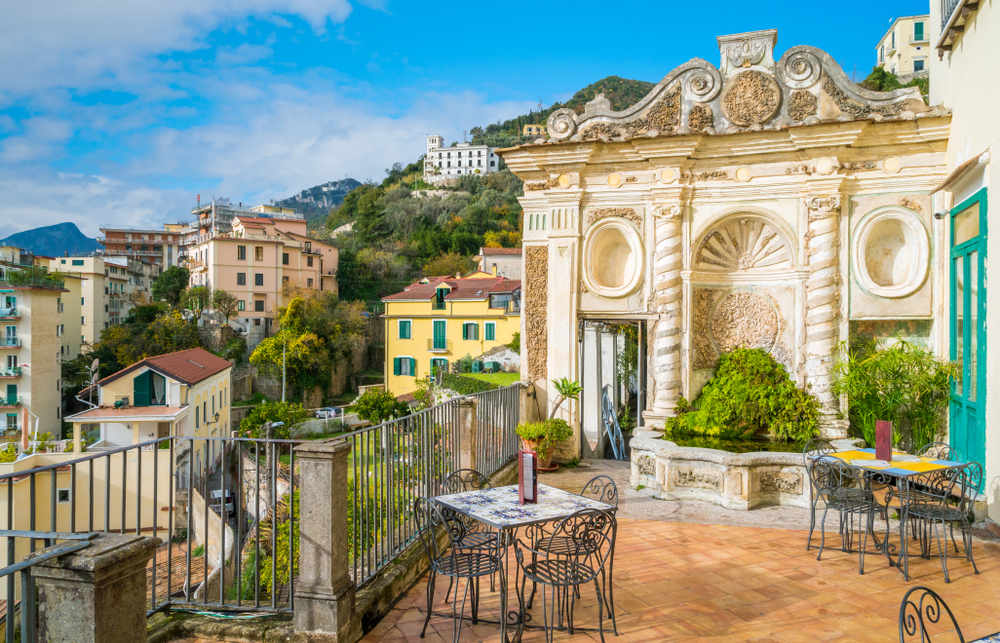
If you do happen to be travelling in or out of the region via Salerno, you may certainly want to take the time to explore its Byzantine castle – the Castello di Arechi – which enjoys great views over the town and the Mediterranean Sea. Also worth admiring is Salerno’s 12th century Romanesque cathedral – the Basilica of Santa Maria degli Angeli. The latter is home to the remains of the Evangelist Matthew, the city’s patron saint, along with the body of Pope Gregorio VII who was buried here. Its courtyard houses the 28 columns from Paestrum. Finally, it’s also worth taking a walk along the Lungomare, the seaside promenade which is actually one of the longest in Italy.
Salerno is also well known for its nightlife scene, called the ‘movida‘. Head to the area around the town hall after 9 pm to join in. After this time, people will gather in the street to chat, eat and to enjoy each other’s company.
Sant’ Agata sui Due Golfi
Sant’ Agata sui Due Golfi is situated between the two gulfs of Naples and Salerno, opposite the island of Capri. It is famous for its sweeping panoramas and the most incredible sea views of any town along the Amalfi Coast. The heart of the town is its main square, home to the 18th century Church of St Agata. Within easy walking distance of this piazza, is the Monastero del Deserto which was constructed by Carmelite monks in 1679. In addition, the area around the town is dotted with evidence of the Greek and Etruscans that once lived here – ancient necropolis in the hills once attracted 19th century travellers as part of Italy’s Grand Tour and still attract holidaymakers today.
Scala
Scala sits in the hills overlooking Ravello. It is one of the oldest villages along the Amalfi Coast, if not the oldest. This picturesque village has a fascinating history. If you opt to hike in the hills surrounding Scala, you will discover some relics of its history in the form of Medieval walls that once protected both Scala as well as Amalfi further down the valley. Back then, Scala would have been an important defensive point for the Republic of Amalfi and this brought much wealth to the merchant families of the village.
This wealth can be seen in the Duomo of San Lorenzo in the heart of the village. Dating back to the 12th century, this is a rather grand building, much larger than any of the churches in Ravello. You can still see the remains of the frescoes that would once have covered a very elaborate facade. Also inside are some beautiful hand painted decorated tiles on the floor and a wonderful painted panel ceiling, both dating back to the 17th century when the church was redecorated in the Baroque style.
Also in the heart of Scala is the bell tower which dominates the piazza. Also in the piazza is the city hall, a school, shops and cafes.
Sorrento
At the Western perimeter of the Amalfi Coast, Sorrento is a larger town and a great base from which to explore the wider area thanks to its excellent transportation links and proximity to both Capri and Pompeii.
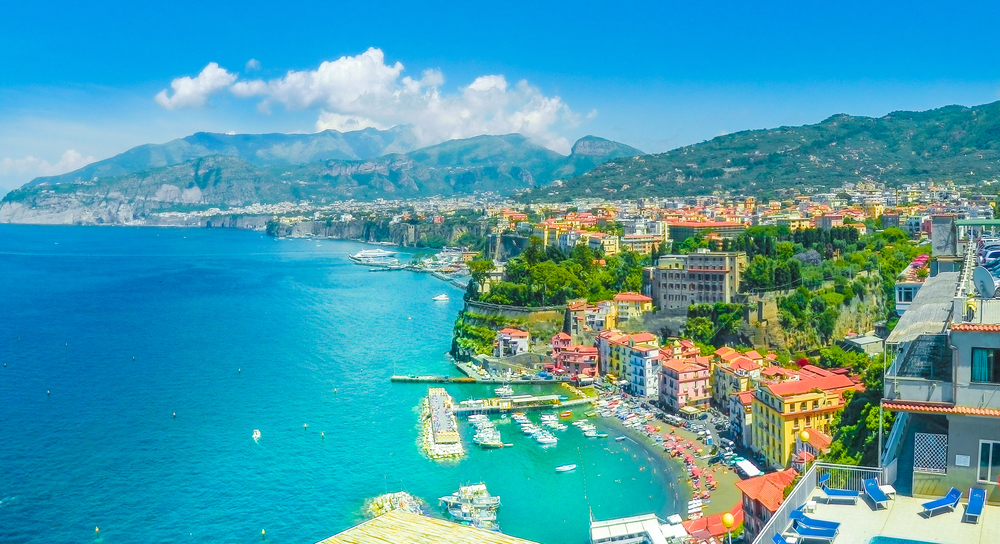
The town is perched on a series of cliffs. Below, there aren’t really sandy beaches to be enjoyed here, but you will find a series of wooden or concrete docks that are perfect to relax on and from where you can jump into the water to enjoy a refreshing swim. The town also boasts some fantastic views of Mount Vesuvius.
The Piazza Tasso is Sorrento’s main square. It’s busy and bustling but we suggest you embrace this, rather than yearning after the sleepier villages of the Amalfi Coast. From here, head to the Via Fuorimura just behind the square where you’ll discover an incredible natural phenomenon – Il Vallone dei Mulino. You can’t actually head into the valley itself, but the view from above down into the abandoned gorge is pretty spectacular. The gorge was formed more than 35,000 years ago by a volcanic eruption but the abandoned mills you see within it date back to the 13th century.
Check out our Sorrento travel guide for more information about what to see and do in Sorrento.
Tramonti
Tramonti sits off the coast, high up in the mountains and 8 km from the sea. It’s a quiet rural area, surrounded by vineyards. The name comes from three words – tra i monti – literally meaning ‘among the mountains.’ Tramonti is actually not a single village but a collection of 13 hamlets set in an idyllic landscape of lemon groves, chestnut woods, olive trees and vineyards. These hamlets are Pucara, Novella, Paterno Sant’ Elia, Figlino, Pietre, Capitignano, Paterno Sant’ Arcangelo, Corsano, Campinola, Polvica, Gete, Ponte and Cesarano. Of these villages, Cesarano is the most important. What happened was that, over time, the population of Cesarano increased and spread throughout this area into a number of small villages on the hillside. Today, all the villages of Tramonti offer a welcome break from the crowded coastline and glamorous resorts. Instead, this is a much more a glimpse into rural, agricultural life.
Vietri sul Mare
Vietri sul Mare is a small coastal town whose quaint streets are delightful to explore. A panoramic piazza sits at each end of the town, with the main street – the Via Corso Umberto I – running between them, off which shoots a plethora of smaller alleyways. The town also boasts a couple of beaches, the largest of which lies on the western edges of the town. In fact the Marina di Vietri here is one of the largest beaches anywhere on the Amalfi Coast. However, the town is arguably most famous for its bright and colourful ceramics – Ceramica Vietrese. This ceramic tradition dates back to the 15th century and ceramic ware is exported from here all over the world.
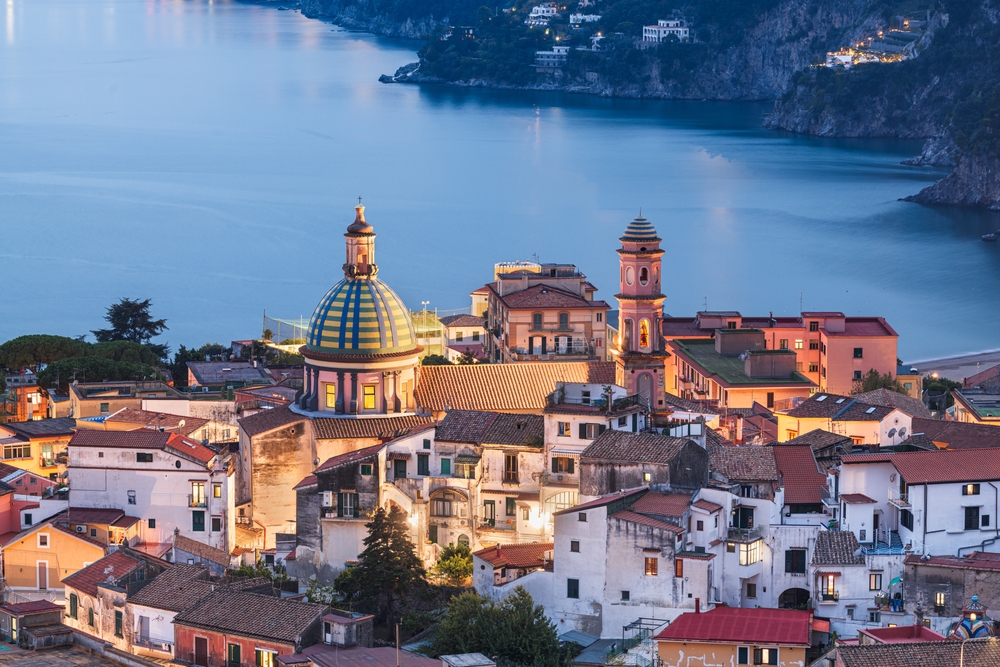
Whilst in Vietri sul Mare, also try and make the time to visit the Church of St Giovanni Battista. This has a late Renaissance facade and an incredibly beautiful majolica cupola.
Don’t forget to check out our top tours and experiences on the Amalfi Coast here. And discover our full collection of stunning Amalfi Coast villas here. Our team at Bookings For You have decades of experience in planning holidays to Italy so be sure to contact us to let us help you find your perfect place in Italy.



